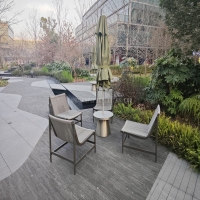Welcome to the website for landscape facilities products and knowledge.
How does the table’s design handle exposure to barbecue smoke or grill residue?
When investing in outdoor furniture, particularly tables destined for barbecue duty, understanding their resistance to smoke and residue becomes crucial. Modern outdoor tables aren't merely aesthetic pieces; they are engineered systems designed to combat the unique challenges of al fresco cooking. The primary defense lies in the material selection and subsequent protective treatments.
High-performance materials like powder-coated aluminum, UV-stabilized polywood, and certain treated hardwoods form the foundation. Powder coating creates a seamless, non-porous shield that prevents smoke particles and oily residues from penetrating the surface. Unlike traditional paint, this baked-on polymer finish resists fading from UV exposure and creates a surface where most grill splatter wipes clean with a damp cloth. For tables made from synthetic lumber, such as polywood, the material itself is impervious to moisture and stains, making it inherently resistant to smoke absorption and sticky residues.
The table's design architecture also plays a pivotal role. Manufacturers are increasingly moving away from intricate carvings and complex joints in favor of smooth, minimalist tops and simple, sturdy legs. This design philosophy minimizes crevices where smoke residue and grease can accumulate, turning a simple wipe-down into an effective cleaning session. Furthermore, many high-end models feature a slight, integrated tilt in the tabletop design to encourage water runoff, which also helps carry away light dust and airborne smoke particles before they can settle and bond.
For the ultimate protection, advanced nano-coatings are now being applied at the manufacturing stage. These ceramic-based sealants form an invisible, molecular layer over the table's surface, creating an exceptionally slick barrier. This barrier not only repels water but also makes it remarkably difficult for grease and smoke film to adhere. Maintenance, therefore, transitions from strenuous scrubbing to occasional gentle washing with mild soap and water.
Ultimately, a table's resilience to barbecue byproducts is a combination of its core material, its intelligent design that avoids dirt traps, and the advanced protective sealants applied. By choosing a table built with these principles, you ensure that your outdoor gatherings remain a pleasure, with cleanup being a swift and simple conclusion to the feast.
Related search:

Recommendation
Metal structure rattan chair without armrests for single person, with woven seat and backrest.